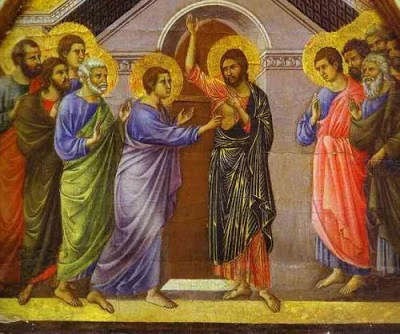Pope Saint John Paul II perhaps understood the sensibility of artists better than most pontiffs. He was, after all, a poet, playwright, and actor himself. His Letter to Artists, written in 1999, deserves special attention among those struggling to find a way to reconcile being an artist with being Christian.
Top Catholic Sculptor Offers Apprenticeships At His Studio - Eligible for Studio Credit with the Pontifex University MSA
An aspiring Catholic artist needs to learn not only the skills of his or her art, but also an understanding our traditions, and how to depart from strict adherence to naturalistic appearances so as to reveal the invisible truths of the Faith. Andrew Smith's training offers an education in both the skills and the Catholic tradition of sculpture.
The Artists and the Church - Paul VI
Faith and Freedom: the Solutions to the Plastic McCulture and the Brutalist Despair of Cultural Marxism
The Artist and the Church Pius XII
St Bartholomew, August 25th - Images of the Saints of the Roman Canon
The Church and Design Competitions
San Quentin State Prison to Have Sung Latin Mass Starting August 25th
The Artist and the Church -Trent
While the Council of Nicaea affirmed the validity of the use of sacred images, the Council of Trent defined the role of art in service to the Church. Still, some Protestant circles would not accept sacred art on any terms and a new wave of iconoclasm stripped many churches of their rich heritage of traditional iconography. But the Council of Trent paved the way for a new generation of artists to work with the Church on sacred imagery that would appeal to the people and be faithful to magisterial teaching. This came to be known as Baroque, or the art of the counter-reformation.
News: TheWayofBeauty.org Podcast Starts Tomorrow, August 16th
The Artist and the Church - Nicaea
"The composition of religious imagery is not left to the initiative of the artist, but is formed upon principles laid down by the Catholic Church and by religious tradition... The execution alone belongs to the painter, the selection and arrangement of subject belongs to the Fathers."
The above quote is often cited as an "instruction" from the Second Council of Nicaea, but this passage is not found in the dogmatic canons issued by the Council. Where does it come from and what does it mean to the contemporary Christian artist?
TheWayofBeauty.org Named As One of the Top Christian Art Blogs on the Web
thewayofbeauty.org has an upgrade courtesy of Carolyn McKinney and Perception Studios. As a result we have been cited as one of the top Christian art blogs on the web by Feedspot. Now we are introducing regular WoB podcasts - coming this month!
Devotion, Design and Decoration - How Liturgical Art Influences the Wider Culture
We need art that is clearly derived from the liturgical forms but is distinct from it and directs us to purest form, so to speak, by being part of the wider culture of faith. This is the beginning of the process by which the liturgy, which is a source of its own culture, begins to push out into the wider culture and transform it into a Christian culture.
Harmony, Order, and the Insight of Bezalel
Modern Russian Relief-Sculpture Icons
The Artist as Storyteller
Stories serve us on many levels. They invite us to consider situations by drawing us in, making us part of the story, making us feel like we are experiencing the struggles and challenges of the protagonist first hand. They may teach us small lessons about life or they may invite us to consider ourselves as part of the bigger picture of the story of our salvation.
Meditation, Contemplation and Transformation; Praying With Sacred Art
In the Western/Christian tradition meditation and contemplation are two different things and often misunderstood. As a result of the The Beatles and the Maharishi Yogi, the words are often used interchangeably to apply to meditative practice of Eastern religions, which is different and less effective, in my experience, than the methods of Christian mysticism.
Looking Forward
God is patient with us. He gives us time. He gives us time to explore our gifts and perhaps even misuse them. But always God is there calling us to discover the proper use of those gifts, to put the past behind us and move forward in our proper work. Whatever your situation is now, whatever mistakes you have made in the past, they are in the past, resolve to put them behind you and go forward, finding the role God has put you here to fulfill.
How Artists Create a Dynamic of Prayer Through Style and Content in Sacred Art
We can distinguish two movements in prayer: one is passive (or receptive) by which we listen to what God is saying to us. The other is active, albeit responding to the prompts of the Holy Spirit, by which we might, for example, give praise or thanks to God or ask something of him. A well-painted piece of sacred art will include stylistic elements (ie going beyond content) that engage the viewer in such a way that it promotes both attitudes of prayer, active and passive,























